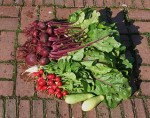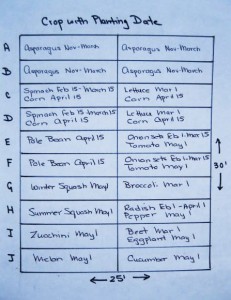 One of the important steps in having a successful vegetable garden is making a plan showing the vegetables you wish to grow and where they will be located in the garden. In addition, a good plan will show the amount of space allotted to each kind of vegetable as well as the placement of the plants and the time they should be planted. By organizing your space you can better utilize your garden and maximize yields. The plan takes a little time to create but is well worth the effort.
One of the important steps in having a successful vegetable garden is making a plan showing the vegetables you wish to grow and where they will be located in the garden. In addition, a good plan will show the amount of space allotted to each kind of vegetable as well as the placement of the plants and the time they should be planted. By organizing your space you can better utilize your garden and maximize yields. The plan takes a little time to create but is well worth the effort.
Before you start with the plan, you need to select the best site for the garden. See my post on How to select a site for a vegetable garden
Here are eleven steps to make a vegetable garden plan.
1. Measure you garden’s dimensions.
2. Assemble a large piece of paper, ruler, pencil, and eraser.
3. Using a simple scale such as half inch equals one foot, draw your garden space to scale on the paper.
4. Indicate North on your drawing.
5. Turn the paper so that North is at the top of the paper and then draw parallel lines 1 1/2″ apart from East to West. These lines represent the (3′ wide) rows of vegetables in your garden. Crops should be run east to west to reduce the amount of shade that one crop creates on another.
6. Measure lengths for each row (depending on how much of each vegetable you want, the rows can be different lengths). A 4′ row is an ideal minimum length for most crops and will encourage you to plant a reasonable amount. If you plan to freeze, can, or store food for winter you may want to increase the length of the row.
7. Place tall crops such as corn, tomatoes, pole beans, and peas on the north side of the garden so that they will not shade other shorter plants.
8. Locate permanent crops such as asparagus along the north end.
9. Make a list of your crops based on botanical families using the list below that includes many commonly grown vegetables. The members of each family share a susceptibility for the same pests and diseases. They should not be grown in the same soil more than every 3-4 years. That is, if potatoes, OR tomatoes, OR peppers, OR eggplants are gown in rows A,B,C,D in your garden this year, you should not grow them in rows A-D again for 3-4 years. For more on crop rotation see my post on How to rotate crops in the home vegetable garden.
Family 1: potato, tomato, eggplant, pepper
Family 2: squash, zucchini, cucumber, cantaloupe, gourds, pumpkins, watermellons
Family 3: beans, peas
Family 4: cauliflower, broccoli, cabbage, turnips, radish, Brussels sprout
Family 5: carrot, celery, parsley, parsnips
Family 6: lettuce, endive, artichokes
Family 7: beets, spinach, Swiss chard
Family 8: onion, garlic, asparagus
Corn, sweet potato , and okra are not in a family with any other common vegetable.
10. Indicate which of your vegetables like cool weather. They can be planted early and many (but not all) will mature in time to allow you to plant a warm weather crop in the same space. These include: lettuce, radish, cauliflower, broccoli, cabbage, turnips, radish, carrot, beets, spinach, Swiss chard , brussel sprout, parsley, parsnips, onion, and garlic.
So, for example, radishes can be planted as soon as the soil warms in spring and are harvested about 30 days later so the same space can be used for another crop such as beans that like warm weather. In mild climates you may be able to plant a cool weather crop like the radishes or carrots when the beans stop producing in late summer.
11. Place the name of the vegetables you wish to grow on the rows in your garden plan with their planting date, keeping in mind the space each plant will occupy at maturity. Check the seed packets for information on spacing or use the following general guidelines.
 Closely Packed (2-8”): beans, beet, carrot, celery, corn, lettuce (leaf, romaine), onion, parsnip, pea, radish, spinach, turnip.
Closely Packed (2-8”): beans, beet, carrot, celery, corn, lettuce (leaf, romaine), onion, parsnip, pea, radish, spinach, turnip.
 Moderately Spaced (9-18”): asparagus, broccoli, cabbage, cauliflower, collards, sweet corn, head lettuce, okra, sweet or hot peppers, irish potatoes, sweet potatoes.
Moderately Spaced (9-18”): asparagus, broccoli, cabbage, cauliflower, collards, sweet corn, head lettuce, okra, sweet or hot peppers, irish potatoes, sweet potatoes.
 Widely Spaced (19-30”): Brussels sprout, cantaloupe, hills of cucumber, eggplant, summer squash including zucchini, tomatoes.
Widely Spaced (19-30”): Brussels sprout, cantaloupe, hills of cucumber, eggplant, summer squash including zucchini, tomatoes.
 Super Spaced (31-60”): pumpkin (48”), winter squash (36”), watermelon (60”)
Super Spaced (31-60”): pumpkin (48”), winter squash (36”), watermelon (60”)
Here’s what your plan might look like:
Note:
 Asparagus in row A and B remains in the ground all year long so you can’t plant another crop before or after it; you also will not include it in a crop rotation.
Asparagus in row A and B remains in the ground all year long so you can’t plant another crop before or after it; you also will not include it in a crop rotation.
 In row H radishes (cool weather crop and fast growing) are planted early in spring followed by peppers (warm weather crop) after the radishes have been harvested.
In row H radishes (cool weather crop and fast growing) are planted early in spring followed by peppers (warm weather crop) after the radishes have been harvested.
If you make the plan in pencil you can easily move things around until you are satisfied that you have the best plan possible. Start designing the vegetable garden long before you intend to plant it so you can try out various possibilities on paper and change things as more possibilities occur to you. The time you spend thinking through possible combinations will pay off when it comes time to plant and harvest.

